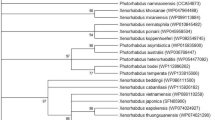Abstract
As an insect pathogen, Photorhabdus luminescens possesses an arsenal of toxins. Here we cloned and expressed a probable toxin from P. luminescens subsp. akhurstii YNd185, designated as Photorhabdus insecticidal toxin (Pit). The pit gene shares 94% nucleotide and 98% predicted amino acid sequence identity with plu1537, a predicted ORF from P. luminescens subsp. laumondii TT01 and 30% predicted amino acid sequence similarity to a fragment of a 13.6 kDa insecticidal crystal protein gene of Bacillus thuringiensis (Bt). The pit was expressed as a GST-Pit fusion protein in E. coli, most of which was insoluble and sequestered into inclusion bodies. The inclusion bodies were harvested and dissolved. The resultant protein was purified and the Pit was cleaved from the fusion protein by thrombin and purified from GST then used for bioassay. Pit killed Galleria mellonella (LD50, 30 ng/larva) and Spodoptera litura (LD50, 191 ng/larva) via hemocoel injection. Relative to a control that lacked toxin, Pit did not significantly increase mortality of S. litura and Helicoverpa armigera when introduced orally, but the treatment did inhibit growth of the insects. The present study demonstrated that Pit possessed insecticidal activity.



Similar content being viewed by others
References
Tu J, Zhang G, Datta K et al (2000) Field performance of transgenic elite commercial hybrid rice expressing Bacillus thuringiensis delta-endotoxin. Nat Biotechnol 18:1101–1104
Sayyed AH, Raymond B, Ibiza-Palacios MS et al (2004) Genetic and biochemical characterization of field-evolved resistance to Bacillus thuringiensis toxin Cry1Ac in the diamondback moth, Plutella xylostella. Appl Environ Microbiol 70:7010–7017
MacRae TC, Baur ME, Boethel DJ et al (2005) Laboratory and field evaluations of transgenic soybean exhibiting high-dose expression of a synthetic Bacillus thuringiensis cry1A gene for control of Lepidoptera. J Econ Entomol 98:577–587
Balarman K, Bhatia MC, Tripathi SC et al (1987) Large scale multiplication of Bacillus thuringiensis H. 14 asporogenic mutants & B. sphaericus strains for mosquito control. Indian J Med Res 85:266–269
Zhao JZ, Cao J, Collins HL et al (2005) Concurrent use of transgenic plants expressing a single and two Bacillus thuringiensis genes speeds insect adaptation to pyramided plants. Proc Natl Acad Sci USA 102:8426–8430
Bloomquist JR, Ferguson HJ, Cox ED et al (1997) Mode of action of β-carboline convulsants on the insect nervous system and their potential as insecticides. Pestic Sci 51:1–6
Roush RT (1989) Designing resistance management programs: how can you choose? Pestic Sci 26:423–441
Poinar GO, Thomas GM, Hess R (1977) Characteristics of the specific bacterium associated with Heterorhabditis bacteriophora (Heterorhabditidae: Rhabditida). Nematologica 23:97–102
Dunphy GB, Webster JM (1988) Virulence mechanisms of Heterorhabditis heliothidis and its bacterial associate, Xenorhabdus luminescens, in the non-immune larvae of the greater wax moth, Galleria mellonella. Int J Parasitol 18:729–737
Duchaud E, Rusniok C, Frangeul L et al (2003) The genome sequence of the entomopathogenic bacterium Photorhabdus luminescens. Nat Biotechnol 21:1307–1313
Brown SE, Cao AT, Hines ER et al (2004) A novel secreted protein toxin from the insect pathogenic bacterium Xenorhabdus nematophila. J Biol Chem 15:14595–14601
Blackburn M, Golubeva E, Bowen D et al (1998) A novel insecticidal toxin from Photorhabdus luminescens, toxin complex a (tca), and its histopathological effects on the Midgut of Manduca Sexta. Appl Environ Microbiol 64:3036–3041
Daborn PJ, Waterfield N, Silva CP et al (2002) A single Photorhabdus gene, makes caterpillars floppy (mcf), allows Escherichia coli to persist within and kill insects. Proc Natl Acad Sci USA 99:10742–10747
Waterfield NR, Daborn PJ, Dowling AJ et al (2003) The insecticidal toxin makes caterpillars floppy 2 (Mcf2) shows similarity to HrmA, an avirulence protein from a plant pathogen. FEMS Microbiol Lett 229:265–270
Lee PJ, Ahn JY, Kim YH et al (2004) Cloning and heterologous expression of a novel insecticidal gene (tccC1) from Xenorhabdus nematophilus strain. Biochem Biophys Res Commun 319:1110–1116
Waterfield NR, Kamita SG, Hammock BD, Ffrench-Constant R (2005) The Photorhabdus Pir toxins are similar to a developmentally regulated insect protein but show no juvenile hormone esterase activity. FEMS Microbiol Lett 245:47–52
Moellenbeck DJ, Peters ML, Bing JW et al (2001) Insecticidal proteins from Bacillus thuringiensis protect corn from corn rootworms. Nat Biotechnol 19:668–672
Bintrim SB, Ensign JC (1998) Insertional inactivation of genes encoding the crystalline inclusion proteins of Photorhabdus luminescens results in mutants with pleiotropic phenotypes. J Bacteriol 180:1261–1269
Forst S, Nealson K (1996) Molecular biology of the symbiotic-pathogenic bacteria Xenorhabdus spp. and Photorhabdus spp. Microbiol Rev 60:21–43
Bowen D, Ensign JC (1998) Purification and characterization of a high-molecular-weight insecticidal protein complex produced by the entomopathogenic bacterium photorhabdus luminescens. Appl Environ Microbiol 64:3029–3035
Morgan JA, Sergeant M, Ellis D et al (2001) Sequence analysis of insecticidal genes from Xenorhabdus nematophilus PMFI296. Appl Environ Microbiol 67:2062–2069
Sergeant M, Jarrett P, Ousley M et al (2003) Interactions of insecticidal toxin gene products from Xenorhabdus nematophilus PMFI296. Appl Environ Microbiol 69:3344–3349
Waterfield NR, Hares M, Yang G et al (2005) Potentiation and cellular phenotypes of the insecticidal toxin complexes of Photorhabdus bacteria. Cell Microbiol 7:373–382
Khandelwal P, Choudhury D, Birah A et al (2004) Insecticidal pilin subunit from the insect pathogen Xenorhabdus nematophila. J Bacteriol 19:6465–6476
Cowles KN, Goodrich-Blair H (2005) Expression and activity of a Xenorhabdus nematophila haemolysin required for full virulence towards Manduca sexta insects. Cell Microbiol 7:209–219
Vigneux F, Zumbihl R, Jubelin G et al (2007) The xaxAB genes encoding a new apoptotic toxin from the insect pathogen Xenorhabdus nematophila are present in plant and human pathogens. J Biol Chem 282:9571–9580
Acknowledgements
We are grateful to the National Natural Science Foundation of China (No. 30170143) and Doctorial Scientific research Set-up Foundation in University of Electronic Science and Technology of China Zhongshan Institute (No. 2007KQ03) for their financial support.
Author information
Authors and Affiliations
Corresponding author
Rights and permissions
About this article
Cite this article
Li, M., Wu, G., Liu, C. et al. Expression and activity of a probable toxin from Photorhabdus luminescens . Mol Biol Rep 36, 785–790 (2009). https://doi.org/10.1007/s11033-008-9246-z
Received:
Accepted:
Published:
Issue Date:
DOI: https://doi.org/10.1007/s11033-008-9246-z



